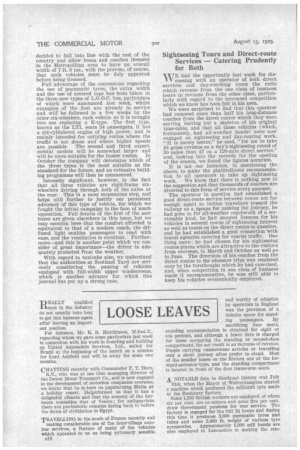Improving London's . Public-service
Page 43

Page 44

If you've noticed an error in this article please click here to report it so we can fix it.
• Passenger Vehicles.
-FOR a long time past there have not been lacking severe criticisms Of the older types of bus in service in the Metropolis. These vehicles, from being the last word -in bus design when they were introduced many years ago, are now woefully behind those employed in many Other parts of the country in respect of comfort, speed, ease of driving and weather protection for the man at the wheel.
We are not alluding to the few quite modern vehicles, such as the six-wheelers, but particularly to earlier machines, including the K-type, which was put on the road in 1919 and has given 10 years of yeoman service.
It must not be considered as a fault of the operating company that improvements on a really large scale have not been carried out before. With a fleet numbering thousands of vehicles drastic changes cannot be made at short intervals, otherwise all the profits would quickly be swallowed up. In the later types the addition of covered tops and, in many instances, pneumatic tyres, has contributed to comfort and speed, whilst, after a hard-fought battle by this journal,, protection for the drivers, in the form of •windscreens, is being added to existing vehicles.
One of the most important criticisms levelled against the London bus is the narrowness of the pairs of seats, which, in the case of passengers of ample proportions, often enforces the unfortunate occupants next to the gangway to be uncomfortably perched on a few inches of seat. This was, however, not due to a fault in the design of the vehicle, but resulted from the strict limitation of overall width to 7 ft. 2 ins. In this connection we now come to an extremely important development. For 21 years the width has been officially that mentioned, but a few years ago some buses of the East Surrey Traction Co., Ltd., which entered the Metropolitan area were given the special concession of an extra half Inch; 0.ater, another operator was permitted to run vehicles one and three-quarter inch above the nominal width, and, comparatively recently, a three-inch overwidth was permitted to allow the use of pneumatic tyres on vehicles not previously so equipped. New, at last, Scotland Yard has decided to fall into line with the rest of the country and allow buses and coaches licensed in the Metropolitan area to have an overall width of 7 ft. 6 ins., with the proviso, of course, that such vehicles must be duly approved before being licensed.
Full advantage of the concessions regarding the use of pneumatic tyres, the extra width and the use of covered tops has been taken in the three new types of L.G.O.C. bus, particulars of which were announced last week, whilst examples of the first are already in service and will be followed in a few weeks by the other six-wheelers, each vehicle as it is brought Into use replacing a K-type. The first type, known as the LT1, seats 54 passengers, it has a six-cylindered engine of high power, and is mainly intended for outlying routes where the traffic is not dense and where higher speeds are possible. The second and third experimental models will be somewhat larger and will be more suitable for the busier routes. In October the company will determine which of the three types is the most suitable as the standard for the future, and an extensive building programme will then be commenced.
Intensely significant, however, is the fact that all three vehicles are rigid-frame sixwheelers driving through both of the axles at the rear. This is a most momentous step, and helps still further to justify our persistent advocacy of this type of vehicle, for which we fought the initial campaign in the face of much opposition. Full details of the first of the new buses are given elsewhere in this issue, but we may mention here that the comfort afforded is equivalent to that of a modern coach, the diffused light enables passengers to read with ease, and the ventilation is excellent. Furthermore—and this is another point which we consider of great importance—the driver is adequately protected from the weather.
With regard to taxicabs also, we understand that the authorities at Scotland Yard are seriously considering the passing of vehicles equipped with full-width upper windscreens, which is another advance for which this journal has put up a strong case.




















































































































